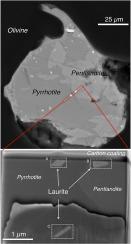Our official English website, www.x-mol.net, welcomes your
feedback! (Note: you will need to create a separate account there.)
Mineralogy of the HSE in the subcontinental lithospheric mantle —An interpretive review
Lithos ( IF 2.9 ) Pub Date : 2020-11-01 , DOI: 10.1016/j.lithos.2020.105681 José M. González-Jiménez , Santiago Tassara , Erwin Schettino , Josep Roqué-Rosell , Julia Farré-de-Pablo , J. Edward Saunders , Artur P. Deditius , Vanessa Colás , Juan J. Rovira-Medina , María Guadalupe Dávalos , Manuel Schilling , Abigail Jimenez-Franco , Claudio Marchesi , Fernando Nieto , Joaquín A. Proenza , Fernando Gervilla
Lithos ( IF 2.9 ) Pub Date : 2020-11-01 , DOI: 10.1016/j.lithos.2020.105681 José M. González-Jiménez , Santiago Tassara , Erwin Schettino , Josep Roqué-Rosell , Julia Farré-de-Pablo , J. Edward Saunders , Artur P. Deditius , Vanessa Colás , Juan J. Rovira-Medina , María Guadalupe Dávalos , Manuel Schilling , Abigail Jimenez-Franco , Claudio Marchesi , Fernando Nieto , Joaquín A. Proenza , Fernando Gervilla

|
Abstract The highly siderophile elements (HSE: Os, Ir, Ru, Rh, Pt, Pd, Re, Au) exist in solid solution in accessory base-metal sulfides (BMS) as well as nano-to-micron scale minerals in rocks of the subcontinental lithospheric mantle (SCLM). The latter include platinum-group minerals (PGM) and gold minerals, which may vary widely in morphology, composition and distribution. The PGM form isolated grains often associated with larger BMS hosted in residual olivine, located at interstices in between peridotite-forming minerals or more commonly in association with metasomatic minerals (pyroxenes, carbonates, phosphates) and silicate glasses in some peridotite xenoliths. The PGM found inside residual olivine are mainly Os-, Ir- and Ru-rich sulfides and alloys. In contrast, those associated with metasomatic minerals or silicate glasses of peridotite xenoliths consist of Pt, Pd, and Rh bonded with semimetals like As, Te, Bi, and Sn. Nanoscale observations on natural samples along with the results of recent experiments indicate that nucleation of PGM is mainly related with the uptake of HSE by nanoparticles, nanominerals or nanomelts at high temperature (> 900 °C) in both silicate and/or sulfide melts, regardless of the residual or metasomatic origin of their host minerals. A similar interpretation can be assumed for gold minerals. Our observations highlight that nanoscale processes play an important role on the ore-forming potential of primitive mantle-derived magmas parental to magmatic-hydrothermal deposits enriched in noble metals. The metal inventory in these magmas could be related with the physical incorporation of HSE-bearing nanoparticles or nanomelts during processes of partial melting of mantle peridotite and melt migration from the mantle to overlying continental crust.
中文翻译:

次大陆岩石圈地幔中HSE的矿物学——解释性评论
摘要 高亲铁元素(HSE:Os、Ir、Ru、Rh、Pt、Pd、Re、Au)以固溶体形式存在于副贱金属硫化物 (BMS) 以及岩石中的纳米至微米级矿物中。次大陆岩石圈地幔(SCLM)。后者包括铂族矿物 (PGM) 和金矿物,它们的形态、成分和分布可能有很大差异。PGM 形成的孤立颗粒通常与残留橄榄石中较大的 BMS 相关,位于橄榄岩形成矿物之间的空隙中,或更常见的是与一些橄榄岩包体中的交代矿物(辉石、碳酸盐、磷酸盐)和硅酸盐玻璃有关。在残余橄榄石中发现的 PGM 主要是富含 Os、Ir 和 Ru 的硫化物和合金。相比之下,与交代矿物或橄榄岩捕虏体的硅酸盐玻璃相关的那些由 Pt、Pd 和 Rh 与 As、Te、Bi 和 Sn 等半金属键合组成。对天然样品的纳米级观察以及最近的实验结果表明,PGM 的成核主要与纳米粒子、纳米矿物或纳米熔体在高温(> 900 °C)下在硅酸盐和/或硫化物熔体中对 HSE 的吸收有关,无论其寄主矿物的残余或交代来源。可以假设对金矿物有类似的解释。我们的观察结果强调,纳米级过程对富含贵金属的岩浆热液矿床的原始地幔源岩浆的成矿潜力起着重要作用。
更新日期:2020-11-01
中文翻译:

次大陆岩石圈地幔中HSE的矿物学——解释性评论
摘要 高亲铁元素(HSE:Os、Ir、Ru、Rh、Pt、Pd、Re、Au)以固溶体形式存在于副贱金属硫化物 (BMS) 以及岩石中的纳米至微米级矿物中。次大陆岩石圈地幔(SCLM)。后者包括铂族矿物 (PGM) 和金矿物,它们的形态、成分和分布可能有很大差异。PGM 形成的孤立颗粒通常与残留橄榄石中较大的 BMS 相关,位于橄榄岩形成矿物之间的空隙中,或更常见的是与一些橄榄岩包体中的交代矿物(辉石、碳酸盐、磷酸盐)和硅酸盐玻璃有关。在残余橄榄石中发现的 PGM 主要是富含 Os、Ir 和 Ru 的硫化物和合金。相比之下,与交代矿物或橄榄岩捕虏体的硅酸盐玻璃相关的那些由 Pt、Pd 和 Rh 与 As、Te、Bi 和 Sn 等半金属键合组成。对天然样品的纳米级观察以及最近的实验结果表明,PGM 的成核主要与纳米粒子、纳米矿物或纳米熔体在高温(> 900 °C)下在硅酸盐和/或硫化物熔体中对 HSE 的吸收有关,无论其寄主矿物的残余或交代来源。可以假设对金矿物有类似的解释。我们的观察结果强调,纳米级过程对富含贵金属的岩浆热液矿床的原始地幔源岩浆的成矿潜力起着重要作用。











































 京公网安备 11010802027423号
京公网安备 11010802027423号